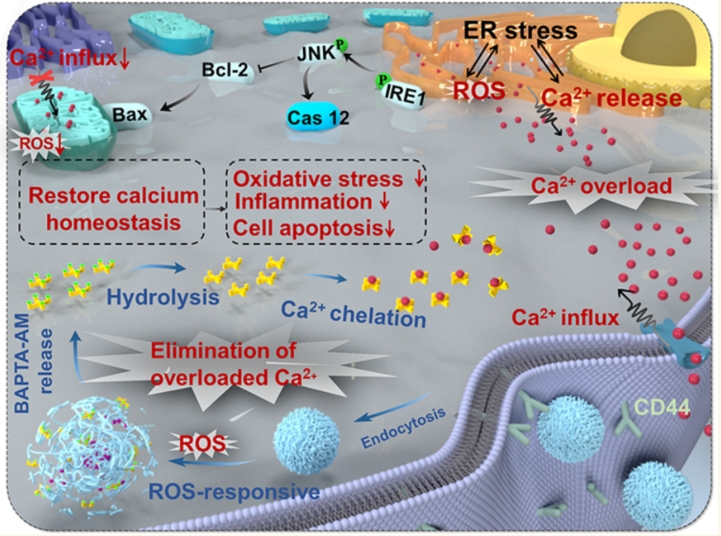Author: Tiffany
Recent research highlights the development of reactive oxygen species (ROS)-responsive hyaluronic acid-bilirubin nanoparticles that deliver the calcium chelator BAPTA-AM to effectively reduce calcium overload and oxidative stress.

Key Highlights
Research Question:
- Can a ROS-responsive nanoparticle delivery system targeting calcium overload mitigate cellular damage and improve treatment outcomes for acute kidney injury (AKI)?
Research Difficulties:
- Encapsulating the hydrophobic BAPTA-AM within nanoparticles while maintaining high stability and kidney-targeted delivery.
- Designing a nanoparticle that responds specifically to ROS in the pathological microenvironment of AKI.
- Achieving effective drug delivery within the narrow therapeutic window of AKI.
Key Findings:
- The nanoparticles reduced intracellular calcium levels by up to 7-fold in vitro and alleviated oxidative stress in kidney cells.
- In a rat model of I/R-induced AKI, the therapy decreased creatinine (69.5%) and BUN (62.4%) levels within 12 hours of administration.
- The nanoparticles significantly reduced apoptosis, oxidative damage, and inflammatory markers in kidney tissue while improving antioxidant enzyme activity.
Innovative Aspects:
- First use of ROS-responsive hyaluronic acid-bilirubin nanoparticles for kidney-targeted delivery of a calcium chelator (BAPTA-AM).
- Combines calcium overload chelation, ROS scavenging, and specific kidney targeting into a single therapeutic system.
Importance of the Study:
- Demonstrates a new pharmacological approach to address the lack of effective therapies for AKI.
- Offers potential applications for other conditions involving calcium overload and oxidative stress.
Background: Calcium Overload in Acute Kidney Injury
Acute kidney injury (AKI) is a severe condition characterized by a sudden decline in kidney function, affecting up to 50% of ICU patients with a mortality rate of 40–50%. The condition often arises from ischemia-reperfusion (I/R) injury, leading to complex pathological cascades including intracellular calcium overload, oxidative stress, and inflammation. Current treatments are limited to supportive care, such as avoiding nephrotoxic drugs and renal replacement therapy, which carries risks and does not directly address the underlying causes of AKI.
One of the main contributors to AKI is calcium overload, which disrupts cellular homeostasis and initiates apoptosis and oxidative damage. Current therapies, such as calcium channel blockers, fail to reverse existing intracellular calcium overload. This study hypothesized that targeting calcium overload and oxidative stress simultaneously with a responsive drug delivery system could mitigate AKI and improve recovery.
Research Aim & Objectives
The research aimed to develop a ROS-responsive nanoparticle system for kidney-targeted delivery of the calcium chelator BAPTA-AM to alleviate calcium overload and oxidative stress in AKI. The system combines hyaluronic acid for kidney targeting, bilirubin for ROS scavenging, and BAPTA-AM for calcium chelation. The nanoparticles were designed to release the therapeutic payload in response to high ROS levels in injured kidney tissues.
The study, led by Yanan Wang and colleagues, sought to evaluate the nanoparticles’ therapeutic efficacy in vitro and in a rat model of I/R-induced AKI.
Research Methods & Results
Key Experiments and Detailed Steps:
1. Nanoparticle Development and Characterization:
- Steps:
- Hyaluronic acid was chemically conjugated with bilirubin using an adipic dihydride linker to form HA-Br.
- BAPTA-AM was encapsulated into the HA-Br polymer using the flash nanocomplexation method, optimizing the mass ratio of HA-Br to BAPTA-AM and the flow rate during mixing.
- The nanoparticles were characterized for size, stability, drug loading efficiency, and morphology using techniques such as dynamic light scattering (DLS) and transmission electron microscopy (TEM).
- Results:
- The optimized nanoparticles had a size of 84.6 nm, encapsulation efficiency of 80%, and a polydispersity index of ~0.135, indicating uniformity and stability.

2. ROS-Responsive Drug Release in Vitro:
- Steps:
- Nanoparticles were exposed to varying concentrations of H₂O₂ (100–200 μmol·L⁻¹) to simulate high ROS levels in AKI.
- Drug release profiles were monitored over time using high-performance liquid chromatography (HPLC).
- Results:
- The nanoparticles released 73–83% of the encapsulated BAPTA-AM within 8 hours in the presence of ROS, confirming their ROS-responsiveness.

3. Calcium Overload Reduction in Cell Models:
- Steps:
- Human embryonic kidney (293T) cells were stimulated with H₂O₂ to induce calcium overload.
- Cells were treated with varying concentrations of nanoparticles, and intracellular calcium levels were measured using flow cytometry.
- Results:
- The nanoparticles reduced intracellular calcium levels by up to 7-fold in a dose-dependent manner, restoring calcium homeostasis to near-normal levels.

4. Therapeutic Efficacy in AKI Rat Model:
- Steps:
- Bilateral renal artery clamping was performed to induce I/R injury in rats.
- Nanoparticles (100 μg·kg⁻¹ BAPTA-AM) were administered 6 hours post-reperfusion.
- Kidney function (creatinine, BUN), oxidative stress markers (SOD, MDA), and histological damage were evaluated.
- Results:
- Creatinine and BUN levels decreased by 69.5% and 62.4%, respectively, within 12 hours.
- Oxidative stress markers showed significant improvement: MDA levels decreased by 68.1%, and SOD activity increased to 178.6 U/mg·prot.
- Histological analysis revealed reduced tubular damage, apoptosis, and inflammation.

concentrations for different groups in AKI animal model
Summary
This study demonstrated the therapeutic potential of BAPTA-AM-loaded ROS-responsive hyaluronic acid-bilirubin nanoparticles (HA-Br NPs) for alleviating acute kidney injury (AKI) by targeting calcium overload and oxidative stress. The authors concluded that the as-prepared formulations significantly restored kidney function, reduced oxidative stress, and alleviated histopathological damage in AKI models. This effect was attributed to the nanoparticles’ dual function of calcium ion chelation and ROS scavenging, which synergistically restored calcium and redox homeostasis. The treatment effectively inhibited apoptosis-related pathways and reduced inflammatory responses in injured kidneys.
Reference:
Wang, Yanan, et al. “1, 2-Bis (2-aminophenoxy) ethane-N, N, N′, N′-tetraacetic acid acetoxymethyl ester loaded reactive oxygen species responsive hyaluronic acid–bilirubin nanoparticles for acute kidney injury therapy via alleviating calcium overload mediated endoplasmic reticulum stress.” ACS nano 17.1 (2022): 472-491.
